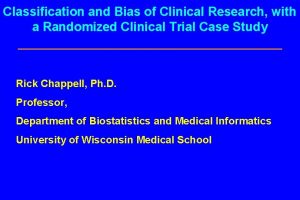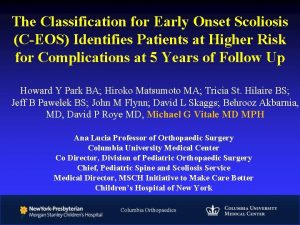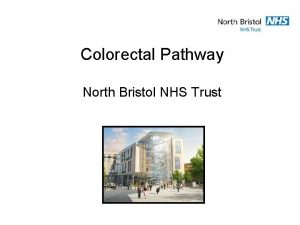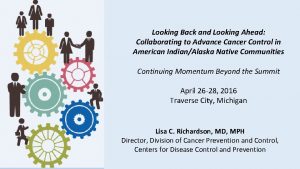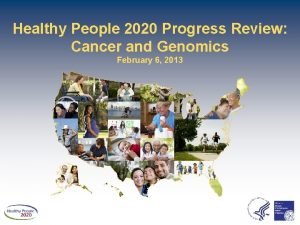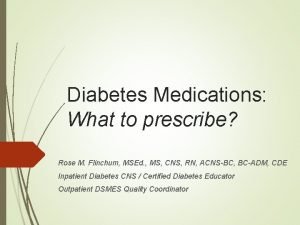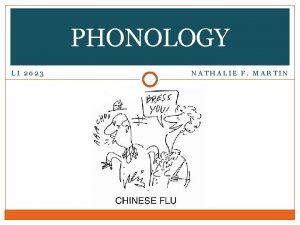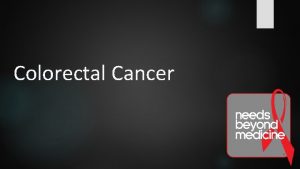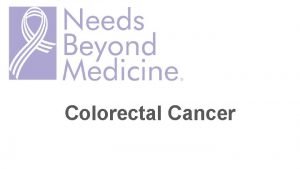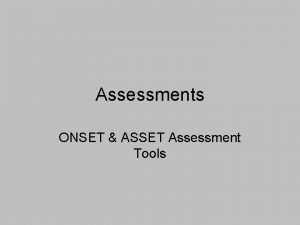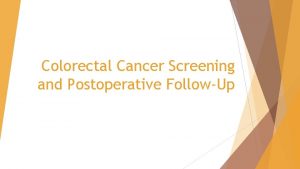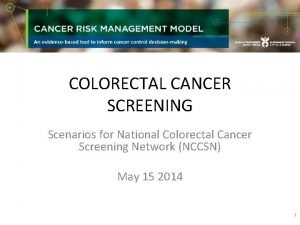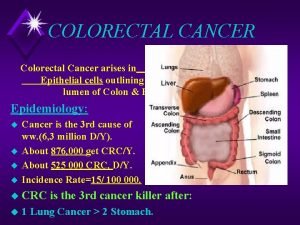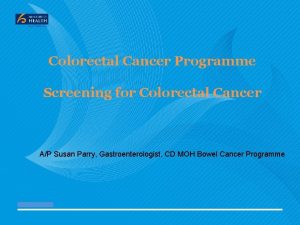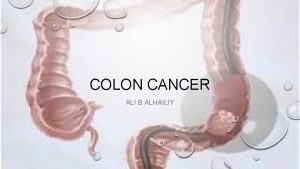Early and lateage onset colorectal cancer in Kentucky
















- Slides: 16

Early- and late-age onset colorectal cancer in Kentucky: using health administrative claims-linked cancer registry data to better understand risk factors and comorbidities Julie S. Townsend, MS Epidemiologist, Division of Cancer Prevention and Control NAACCR/IARC Conference June 13, 2019

CRC in Kentucky Considerable progress in reducing overall CRC incidence rates • Collaborative and strategic efforts to expand CRC screening across the state • Incidence rates peaked in 2001 at 64. 0 per 100, 000 • Lowest incidence rates in 2015 at 48. 4 per 100, 000 2 Division of Cancer Prevention and Control Reliable. Trusted. Scientific.

Background Early-onset Colorectal Cancer (CRC): diagnosed before age 50 years • In the United States, incidence and death rates for colorectal cancer (CRC) have been increasing in persons aged <50 years • Relatively rare among persons aged < 50 years: 7. 6 cases per 100, 000 in the US from 2011 – 2015 • Highest incidence rates over past 5 years in Kentucky (9. 6 per 100, 000) among persons < 50 years 3 Division of Cancer Prevention and Control Reliable. Trusted. Scientific.

CRC Risk Factors • • • Age Inflammatory bowel disease Personal or family history of CRC or polyps Genetic syndromes Overweight/obesity Alcohol use Tobacco use Lack of physical activity High dietary intake of processed meats • Physical activity • Diet high in fiber, fruits, and vegetables 4 Division of Cancer Prevention and Control Reliable. Trusted. Scientific.

Purpose Study Question To better understand these trends, we sought to examine risk factors, comorbidities, and screening test use among Kentucky CRC patients 5 Division of Cancer Prevention and Control Reliable. Trusted. Scientific.

Methods Data linkages between Kentucky Cancer Registry and health administrative claims data • Years: 2007 – 2011 • Registry data probabilistically linked to claims data from a set of public (including Medicare and Medicaid), state employee database, and private Kentucky insurers • Inclusion criteria: • First primary CRC cases • Continuously enrolled for one year prior to their cancer diagnosis • Had at least 1 claim • ICD 9 and CPT codes from claims data captured chronic conditions, screening test use, and risk factors • Captured within 1 year prior diagnosis • Descriptive analysis in SAS comparing early-onset to late-onset CRC patients • Demographic and tumor characteristics • Comorbidities, CRC risk factors, family history of CRC • Screening test use • Average time from screening to diagnosis confirmation, to initial treatment 6 Division of Cancer Prevention and Control Reliable. Trusted. Scientific.

Results Kentucky, 2007 - 2011 Earlyonset (<50), n=299 7 Division of Cancer Prevention and Control Age group: < 30: 5. 4% 30 – 39: 19. 1% 40 – 49: 76. 9% Lateonset (50+), n=5, 856 Age group: 50 – 64: 18. 5% 65 – 74: 36. 6% 75+: 45. 8% Reliable. Trusted. Scientific.

Early-onset CRC patients were more frequently male, had rectal cancer, and no other comorbidities NOS Rectosigmoid Colon Rectum No other chronic conditions 1 to 2 3 or more African American White Female Male 0. 0% 10. 0% 20. 0% 30. 0% 40. 0% Late-onset 8 Division of Cancer Prevention and Control 50. 0% 60. 0% 70. 0% 80. 0% Early-onset Reliable. Trusted. Scientific. 90. 0% 100. 0%

Regional and distant stage tumors were more common among earlyonset CRC patients 45. 0% 40. 0% 41. 9% 37. 5% 33. 9% 35. 0% 30. 0% 23. 1% 25. 0% 19. 4% 20. 0% 15. 0% 10. 0% 5. 0% 2. 0% 4. 8% 0. 0% Local stage Regional stage Early-onset Distant stage Unstaged Late-onset However, these differences among early- and late-onset patients were not drastically different 9 Division of Cancer Prevention and Control Reliable. Trusted. Scientific.

Mean time to diagnosis and treatment did not differ among early- and late-onset CRC patients in Kentucky Early-onset Late-onset Mean time from diagnostic colonoscopy to CRC diagnosis 18. 95± 58. 79 22. 62± 61. 40 Mean time from CRC diagnosis to treatment initiation 13. 04± 18. 85 14. 43± 23. 41 There was considerable variation in mean time to diagnosis in both age groups 10 Division of Cancer Prevention and Control Reliable. Trusted. Scientific.

Family history of CRC, IBD, obesity, and use of smoking cessation medications were more common among early-onset CRC patients Family history of CRC High triglycerides/reduced HDL cholesterol Hypertension Use of smoking cessation medications History of tobacco use IBD Obesity Diabetes 0. 0% 10. 0% 20. 0% Late-onset 30. 0% 40. 0% 50. 0% 60. 0% 70. 0% 80. 0% 90. 0% 100. 0% Early-onset Late-onset CRC patients had higher prevalence of diabetes, hypertension, and poor lipid profiles 11 Division of Cancer Prevention and Control Reliable. Trusted. Scientific.

Early-onset CRC patients more frequently had colonoscopy Other Sigmoidoscopy 3. 0% 2. 0% 4. 7% 3. 3% 63. 6% 69. 6% Colonoscopy FOBT/FIT 12. 8% 11. 0% 0. 0% 10. 0% 20. 0% 30. 0% 40. 0% 50. 0% 60. 0% 70. 0% 80. 0% 90. 0% 100. 0% Late-onset 12 Division of Cancer Prevention and Control Early-onset Reliable. Trusted. Scientific.

Limitations The primary purpose of claims data is for billing, so it can’t always address every research question • Obesity prevalence based on claims data was severely underestimated • Examined risk factors in the year prior to diagnosis, so long term history was not collected • May affect obesity prevalence, because weight loss associated with advanced CRC • Difficult to discern screening colonoscopy vs. diagnostic colonoscopy • Excluded the uninsured 13 Division of Cancer Prevention and Control Reliable. Trusted. Scientific.

Summary Supplementing cancer registry data with claims data has many benefits • Claims data useful to identify comorbidities and screening test use • The linkage included Medicaid and privately insured patients • In Kentucky, early-onset CRC patients more frequently had obesity, family history of CRC, and IBD than older counterparts • Diabetes and tobacco-use history both relatively common in early- and late-onset CRC patients • These findings indicate that many early-onset CRC patients may be at risk for a second cancer given their history of obesity, diabetes, and tobacco use • Improved recognition of these risk factors in people under age 50 may allow for healthcare discussions about starting screening earlier, if appropriate 14 Division of Cancer Prevention and Control Reliable. Trusted. Scientific.

Acknowledgements: Kentucky Cancer Registry Bin Huang, Dr. PH Quan Chen, Dr. PH Eric Tai, MD, MS

Thank you! Go to the official federal source of cancer prevention information: www. cdc. gov/cancer Division of Cancer Prevention and Control Reliable. Trusted. Scientific. The findings and conclusions in this report are those of the authors and do not necessarily represent the official position of the Centers for Disease Control and Prevention.
 Colorectal cancer drug trial
Colorectal cancer drug trial Colorectal cancer
Colorectal cancer Amsterdam 2 criteria
Amsterdam 2 criteria Early onset scoliosis classification
Early onset scoliosis classification Ann lyons colorectal surgeon
Ann lyons colorectal surgeon Polyp
Polyp National breast and cervical cancer early detection program
National breast and cervical cancer early detection program National breast and cervical cancer early detection program
National breast and cervical cancer early detection program Breast cancer anatomy and early warning signs
Breast cancer anatomy and early warning signs Kentucky governor's office of early childhood
Kentucky governor's office of early childhood Early cpr and early defibrillation can: *
Early cpr and early defibrillation can: * Continuous subcutaneous infusion
Continuous subcutaneous infusion Egregious eleven
Egregious eleven Language
Language Phonology questions
Phonology questions Onset coda and nucleus
Onset coda and nucleus Onset and coda examples
Onset and coda examples
